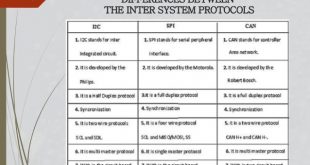In today’s fast-paced digital era, where innovation unfolds rapidly and customer expectations continuously evolve, Software Release Management (SRM) plays a pivotal role in ensuring the seamless delivery of high-quality software. SRM encompasses the strategic planning, scheduling, and execution of software releases throughout the development lifecycle. Acting as the critical bridge …
Read More »Navigating the World of Power Conversion: From SMPS to Space-Level DC-DC Converters
Introduction: In the landscape of electronics, the efficient conversion of power is paramount. Whether it’s for everyday consumer gadgets or critical military and aerospace applications, the ability to convert direct current (DC) from one voltage level to another is a fundamental requirement. Power conversion plays a critical role in ensuring efficiency, …
Read More »Unraveling the Future of Signal Processing: Optical Devices Redefining Real-Time Edge Computing
Introduction: In the realm of signal processing, a groundbreaking innovation is underway, poised to redefine the landscape of computational capabilities. Optical devices equipped with features supporting physical reservoir computing are at the forefront of this revolution, enabling real-time signal processing across a broad range of timescales within a single device. …
Read More »Unraveling the Complexity of Device Drivers: Kernel & User Drivers, Block Drivers, Character Drivers, and Software Drivers
In the realm of computing, device drivers serve as the crucial link between hardware components and the operating system. They enable seamless communication, ensuring that software can interact with various hardware peripherals effectively. Device drivers come in different types, each tailored to specific hardware functionalities and system requirements. In this …
Read More »Navigating the Cosmos: Exploring the Global Large Satellite Propulsion and AOCS Subsystem Market
Introduction: The cosmos has always been a realm of fascination and exploration for humankind. As our ventures into space expand, the demand for sophisticated satellite propulsion and attitude and orbit control subsystems (AOCS) has surged. In this blog post, we’ll delve into the dynamics of the global large satellite propulsion …
Read More »The Language of Devices: Exploring Communication Protocols in Embedded Systems
Embedded systems are the unsung heroes of modern technology, quietly powering a vast array of devices and systems that we interact with every day. From smartwatches and digital cameras to industrial machinery and autonomous vehicles, these systems play a critical role in shaping our world. At the heart of every …
Read More »Pushing the Limits: The Importance of Aerospace Propulsion Systems Testing
In the dynamic world of aerospace engineering, where innovation is the norm and pushing the boundaries of technology is a daily pursuit, one critical aspect stands out – propulsion systems testing. These tests form the backbone of aerospace development, ensuring safety, reliability, and performance in the skies and beyond. The …
Read More »Unlocking the Mysteries: The Surprising Link Between Light and Magnetism
Light and magnetism – two fundamental forces that appear worlds apart. Yet, beneath the surface, a surprising truth emerges – they are intricately linked, shaping the very fabric of our universe. A Historical Mystery: A Spark of Curiosity For centuries, scientists viewed light and magnetism as separate phenomena. Then, in …
Read More »Navigating the Quantum Communication Market: Opportunities and Innovations
Introduction: In the realm of modern communication technologies, quantum communication stands out as a frontier with immense potential. Harnessing the principles of quantum mechanics, this cutting-edge field promises unparalleled security and efficiency in data transmission. As industries and governments seek robust solutions to safeguard sensitive information and enable secure networks, …
Read More »Real-Time Operating Systems (RTOS): Powering Timely Decisions in Embedded Systems
Introduction: Real-time operating systems (RTOS) play a crucial role in the development of embedded systems, where precise timing and responsiveness are essential. From automotive systems to medical devices and industrial automation, RTOS enables developers to meet stringent timing requirements and ensure reliable performance. This article provides an in-depth exploration of …
Read More » International Defense Security & Technology Your trusted Source for News, Research and Analysis
International Defense Security & Technology Your trusted Source for News, Research and Analysis



